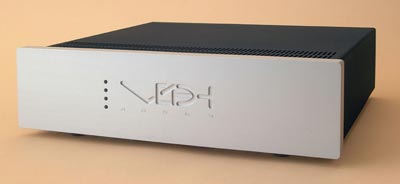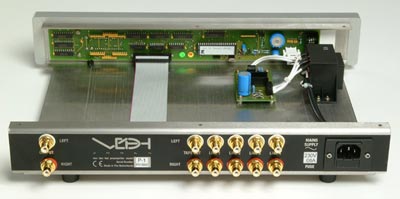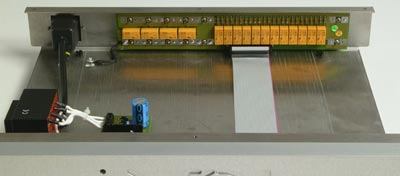You are reading the older HTML site
Positive Feedback ISSUE
4december/january 2003
the Array P-1 preamplifier and S-1 amplifier
as reviewed by Francisco Duran, Ed Morawski, and Danny Kaey

VDH S-1 amplifier

VDH P-1 preamplifier
FRANCISCO DURAN'S SYSTEM LOUDSPEAKERS ELECTRONICS SOURCE CABLES ACCESSORIES
|
 With the P-1 preamplifier and S-1
amplifier, Van den Hul has quite an interesting set of electronics on offer. The Array
Model P-1 passive preamplifier boasts a host of useful features that make most other
passive designs look Spartan, although the Array P-1 has no knobs on its faceplate. Not to
worry, you won't have to switch modes and adjust volume by mental telepathy—the
preamp comes with a universal remote control that has the ability to control up to six
components. Some of the programming options are quite useful. You can control volume and
select among the four inputs, and there is a mute function. Then it gets interesting. You
can adjust level for sources that differ in output. You can even change the speed of the
volume control, but what really caught my attention is that input and output impedance can
be adjusted! These functions will enable the P-1 user a great deal of flexibility in
mating this unit with different sources and amplifiers.
With the P-1 preamplifier and S-1
amplifier, Van den Hul has quite an interesting set of electronics on offer. The Array
Model P-1 passive preamplifier boasts a host of useful features that make most other
passive designs look Spartan, although the Array P-1 has no knobs on its faceplate. Not to
worry, you won't have to switch modes and adjust volume by mental telepathy—the
preamp comes with a universal remote control that has the ability to control up to six
components. Some of the programming options are quite useful. You can control volume and
select among the four inputs, and there is a mute function. Then it gets interesting. You
can adjust level for sources that differ in output. You can even change the speed of the
volume control, but what really caught my attention is that input and output impedance can
be adjusted! These functions will enable the P-1 user a great deal of flexibility in
mating this unit with different sources and amplifiers.
The Array S-1 stereo power amplifier is equipped with thirty-two 120 MHz power transistors per channel. Each channel’s output stage has eight cascaded sections in parallel. This is said to achieve -100dB distortion at just 40dB of local feedback. The amp has balanced topology input stages. The front panel warning indicators are for voltage and current clipping, and will warn of power line irregularities. Both the amp and preamp look classy in an understated way, with their brushed aluminum faceplates and black chassis.
I started by comparing the P-1 with my Reference Line 1A Passive. I listened to it with both my 22-watt Canary amp and the Antique Sound Labs MG-SPM25DT monoblocks. The ASLs retail for $900 a pair, and are quite a bit of amplifier for the money. The Canary is substantially more expensive at $4250, and a jump up in performance. Playing the song "Blues for Blanche" by Art Pepper (APO Records) with both amps, the Reference Line was just a shade more open and extended through the mids and treble. Depending on your system, this could be good or bad. My ProAc speakers are revealing enough without needing extra prompting, so a little roundness is welcome. The P-1's performance in the mid to lower treble made the music just a little less stressful and more pleasing. Things also sounded a tad less crisp than with the Reference Line. This was good! The P-1 displayed plenty of detail and atmosphere, and was also just a little sweeter.

VDH P-1 preamplifier rear
Dynamic shadings and contrasts could be heard clearly on Doug MacLeod’s You Can't Take My Blues CD. The stage depth and width on Arvo Part's Te Deum clearly differed from that of Tom Petty’s Wildflowers. The P-1 showed that Petty was singing in a recording booth on a few of the songs, yet details like this weren't mercilessly thrown in my face—they sounded like a natural part of the music. I felt the dynamic performance of the two passives to be equal, as was their ability to throw a soundstage. In convenience features, however, the P-1 leaves the Reference Line in the dust, especially with its ability to adjust volume and input and output impedance from the remote.
With the A-1 installed in my system, I again played the Art Pepper disc, as well as some Moody Blues and Igor Stravinsky. The A-1 also offers quite a bit of performance for the money. Although I noticed more air around instruments with the tube amps, the A-1 held its own in this regard. The P-1/A-1 combo threw a very spacious, open soundstage. From the midrange up, the A-1 sounded smoother and slightly (to my surprise) darker than my tube amps. Again, though, I felt this made long-term listening more enjoyable. I want to be soothed by the music, not hammered. As with the P-1, the details are there, but are not overly emphasized. I kept going back to the Art Pepper "Blues for Blanche" cut with the VdH combo because, well, it sounded so great.
If a component can bring out the subtle dynamic shifts that a drummer is doing, that’s great. If it can let me hear slight pitch variations in the bass playing of Steve Rodby or Christian McBride, I'm happy. The A-1/P-1 combo passed these tests. Sure, I can hear more bass texture with the Canary amp, but we are talking four 300B tubes. The A-1 is lively and quick on its feet in the lower registers, and doesn't trip up on complex bass material. The Van den Hul A-1 and P-1 make it enjoyable to listen to music, which to me is the highest recommendation. I consistently found myself wanting to put on disc after disc and enjoy the music rather than being concerned how each disc sounded. Whether I was listening to my tuner, TV, or CDs, the Van den Hul units knocked me back into my couch, rubbed my shoulders, and urged me to listen and relax. The designer of these components knows the importance of music over sound. Francisco Duran
ED MORAWSKI'S SYSTEM: LOUDSPEAKERS ELECTRONICS SOURCE CABLES
|
 To many seeking the holy grail of
audio, passive preamps have been proclaimed the ultimate in non-coloration, but my
personal experience has not borne this out. I tried a very famous one and was rather
underwhelmed. Also, my Resolution Audio Opus 21 CD player has a built-in passive preamp,
in the form of an analog-domain gain control. When I connected the Opus 21 directly to my
Plinius SA-102 amp, the music sounded flat and lifeless. The stunning dynamics I was used
to with the Plinius CD-LAD active preamp were gone.
To many seeking the holy grail of
audio, passive preamps have been proclaimed the ultimate in non-coloration, but my
personal experience has not borne this out. I tried a very famous one and was rather
underwhelmed. Also, my Resolution Audio Opus 21 CD player has a built-in passive preamp,
in the form of an analog-domain gain control. When I connected the Opus 21 directly to my
Plinius SA-102 amp, the music sounded flat and lifeless. The stunning dynamics I was used
to with the Plinius CD-LAD active preamp were gone.
However, when I was asked to review the Van den Hul Array P-1 passive preamp, I quickly agreed. The VDH consists of a passive signal path and a control circuit. The signal path is equipped with sealed relays with gold-plated silver alloy contacts and metal foil resistors. The P-1 has a microprocessor that calculates and controls resistor networks in an optimal combination of series and shunt resistors in half-decibel steps. The microprocessor can also be programmed to compute the load impedance. Also, the attenuation of the four inputs can be individually programmed, so that the transition from, say, a tuner with low output voltage to a CD player with high output voltage, is seamless. The P-1 has no controls on the front, but all functions are accessible by remote control. The P-1 is a substantial beast. Perhaps it is the three-quarter-inch-thick aluminum front plate, or the solid metal enclosure, or just all the heavy resistors inside? It is extremely well built and attractive.

VDH P-1 preamplifier inside rear

VDH P-1 preamplifier inside front
I connected the P-1 between my Opus 21 CD Player and Plinius SA-102 amplifier and applied power. When it started madly clicking I thought there was something wrong, but apparently it automatically goes to a preset level and remains there, so you don't inadvertently blow up your amp. A nice touch. After that panic, I sat back and was struck by the total silence in my room. Although my reference system is noise free, the P-1 is like a black hole. It is also invisible with regard to coloration. I was about to write that it sounds excellent, but it really has no sound. It is inaudible in every sense of the word. This is also the first passive I've heard that retains dynamics, resolution, and musicality. I played my favorite Lorenna McKennitt CD, The Mask and the Mirror, and its luscious sounds just leaped out of the black silence. On the first track, "Mystic Dreams," someone is "playing" what sounds like a piece of sheet metal by bending it back and forth. This starts about three minutes into the track, and is so far in the background that you may wonder if you are imagining it. The P-1 portrays this sound perfectly, blending it in but allowing you to hear it. I listened to another current favorite, Lara St John's Bach Concertos, and the violins soared distinctly yet soulfully. On the first few tracks, this CD has a French piano deep in the background. The delicate notes are almost an illusion, and it takes a great system to appreciate the blend of St John's almost overwhelming violin and the piano. Again, the P-1 brought it to life just as the producer intended.
After two weeks of joyful listening, I am hard pressed to find any fault with the P-1. Imaging, resolution, bass reproduction, freedom from noise, lack of coloration of any kind—it excels at them all. The volume control, despite being electronic, was always able to deliver exactly the right level. Perhaps because of my very small room, I love a wide, wide soundstage. The P-1 can be faulted just a tiny, tiny bit in that area. The Plinius CD-LAD is a little more expansive, though the P-1 bests it in the background noise department. Unfortunately, it is costly, but if you want top quality and nothing in your signal path except the music, the Van den Hul Array P-1 is your answer.
As anxious as I was to audition the P-1 passive preamp, Van den Hul’s accompanying power amp was a different matter. Not another amplifier! After a week of procrastinating, I pulled it out of the box. Although identical in design to the P-1, for some reason the front is a lighter silver than the P-1. While they don't exactly clash, they do look a little strange next to each other. Appearances aside, I wasn't expecting much. The specs say the S-1 has something like thirty-two output transistors and makes no mention of class A, or AB, or any other class of operation. I browsed their website, and discovered some technical information which discusses the disadvantages of Class A, AB, and B, but does not state which is being used.
I connected the S-1 to the P-1 and my Resolution Audio Opus 21 CD player and let it warm up for the day. That night, the Mask and the Mirror went back into the player, and when the first notes leaped into the air I was simply stunned. Never have I heard such clarity! As the CD played, my mouth remained open, and I realized what was happening. The VDH S-1 didn't sound good or bad. It was simply doing exactly what the P-1 passive did—portraying the music. Never had I heard an amplifier that was so totally neutral. This was confirmed on many more CDs—Keiko Matsui's Deep Blue, Lara St John's Bach Concertos, Vanessa Mae's Storm, Fleetwood Mac's Rumours, and on and on. I couldn't get up to leave the room. The soundstage was wide and expansive, the imaging so pinpoint I could practically see the performers, and the clarity was so stunning I kept listening for harshness or grain or brightness, but on well-recorded CDs there just wasn't anything except fantastic sound.
The S-1 is revealing, and somewhat ruthlessly so. As much as I love Eve Cassidy, I wish she had had the benefit of a better recording studio and producer. The S-1 revealed every flaw in the recording, plus some I hadn't heard before. I could even hear what sounded like someone dropping something in the room. Would you trade ultra-high resolution for a more forgiving amplifier? Not me! I guess I will just live with the flaws. The S-1 surprised me. It sounded better than my Plinius SA-102, which is warmer, both musically and temperature wise—the VDH S-1 never even got warm to the touch, while the SA-102 will drive you out of the room. If the sound had been exactly the same, the lack of heat from the S-1 would have been enough to consider a switch.
After this, I did a lot more research into Van den Hul and discovered that their main claim to fame is cables and cartridges. How does a company that mainly makes cartridges come up with a passive preamp and power amp that sound this good? And why do they sound so good? I can understand the P-1, but the S-1 just confounds me. The specs don't look that good, and the design is complicated, with a lot of components in the signal path. Whatever A.J. Van den Hul is doing, he is doing it right! The P-1 and S-1 are still connected as I write this, a rarity at my place, and the highest compliment I can pay audio gear. Ed Morawski
DANNY KAEY'S SYSTEM LOUDSPEAKERS ELECTRONICS SOURCE CABLES
|
 Who is A.J. Van den Hul, and what
makes his designs stand out? His obsession with audio came at a young age, when he played
with his father’s tube gear and old radios. After college, he began to experiment
with different approaches to music playback problems. His phono cartridges are well known,
but I was unaware of his electronics until I received the P-1 preamp and S-1 amp for
review. Van den Hul’s approach to amplifier/preamplifier design emphasizes two
things: bandwidth and minimalism. Of course, everyone has his or her own ideas about what
should and shouldn’t be implemented in the "perfect" component, but how
about a frequency range up to 360kHz? Or a passive preamp that acts solely as a source
switcher with a built-in, microprocessor-controlled volume control?
Who is A.J. Van den Hul, and what
makes his designs stand out? His obsession with audio came at a young age, when he played
with his father’s tube gear and old radios. After college, he began to experiment
with different approaches to music playback problems. His phono cartridges are well known,
but I was unaware of his electronics until I received the P-1 preamp and S-1 amp for
review. Van den Hul’s approach to amplifier/preamplifier design emphasizes two
things: bandwidth and minimalism. Of course, everyone has his or her own ideas about what
should and shouldn’t be implemented in the "perfect" component, but how
about a frequency range up to 360kHz? Or a passive preamp that acts solely as a source
switcher with a built-in, microprocessor-controlled volume control?
As usual, the first task I performed was to inspect the production quality. The fit and finish of the P-1 and S-1 are superb, with clean lines characterizing the design of both products. Their back ends feature big, thick RCA outputs and inputs, nicely laid out and implemented. I only have two gripes. First, the layout is a bit too clean. There are no knobs, dials, or switches on either faceplate—no on/off switches, no power buttons, no volume knobs, NOTHING! In other words, you absolutely must use the supplied remote to operate this equipment. I have seen all sorts of remote controls: big ones, thin ones, ones that were literally carved out of wood, chunks of steel you need a fork lift to pick up. Van den Hul’s solution? Source the remote from Philips. This is my second gripe. As I recall, Philips makes some pretty darn cool remotes, but this twenty-dollar plastic item has no part in a system so obviously meant to be esthetically pleasing.
 Enough complaining. Let’s move on to the "sound check." I plugged
the VdH gear into my little setup, consisting of Reimer McCullough speakers, Analysis-Plus
cables, and Audio Note CD player. Fortunately, as I was the last guy on the block to
review these pieces, they were already burned in, and immediately revealed the principal
aspect of their performance—ultra-high resolution. On well-recorded tracks, the sound
was superb. Kruder & Dorfmeister, a popular Austrian DJ duo, have made an art form out
of mixing and sampling. Fortunately, their recording standards are also high, so you can
enjoy drum-and-bass with a smile on your face. The VdHs hit me with such authority,
timing, and power that I was amazed. They reminded of the Marsh gear I reviewed a while
back, except they had higher resolution without sounding harsh, opened up the stage just a
tad more, and delivered precise timing, never hindering the flow of the music.
Enough complaining. Let’s move on to the "sound check." I plugged
the VdH gear into my little setup, consisting of Reimer McCullough speakers, Analysis-Plus
cables, and Audio Note CD player. Fortunately, as I was the last guy on the block to
review these pieces, they were already burned in, and immediately revealed the principal
aspect of their performance—ultra-high resolution. On well-recorded tracks, the sound
was superb. Kruder & Dorfmeister, a popular Austrian DJ duo, have made an art form out
of mixing and sampling. Fortunately, their recording standards are also high, so you can
enjoy drum-and-bass with a smile on your face. The VdHs hit me with such authority,
timing, and power that I was amazed. They reminded of the Marsh gear I reviewed a while
back, except they had higher resolution without sounding harsh, opened up the stage just a
tad more, and delivered precise timing, never hindering the flow of the music.
Dave Brubeck’s Take Five, a favorite of mine, displayed similar qualities. Van den Hul’s design philosophy seems to have paid off in a big way. The music’s pace, flow, and absolute lack of congestion are no doubt due to the combo’s ultra-high bandwidth. Brubeck and his quintet were up to speed, and you don’t feel left out, if that is what you want. "Huh?" you say. Permit me to explain. Until recently, I was all for the revealing nature of mini-monitor sound. I considered myself a purist. Lately, however, I have grown to love tube sound, courtesy of a review I am working on, and have come to realize that there is more to music playback than resolution. Not that tube gear lacks detail, but it adds a sense of emotion to the performance. While the VdH gear is all that it can be when it comes to resolution, it omits the sweetness and immediacy that comes with a musical performance.
At one point during the review period, I did a little mixing and matching. I replaced the VdH amp with the Cary SLP-88, thinking that an ultra-high-resolution preamp funneling music through a tubed amp might be the holy grail of performance. Well, it ain’t. The performance did become somewhat more inviting, but it was like putting together a puzzle in which the image is reversed. I came to the conclusion that mixing and matching doesn’t add up sometimes. With the VdH amp back, everything was in order. The more personable character was gone, but the picture looked much brighter and cleaner.
A.J. Van den Hul has done a commendable job with these products. They do what they are supposed to do without calling too much attention to themselves (no expensive, refrigerator-size style housings, etc.). In my opinion, the VdH gear will be at home in a setup in which the speakers are a bit on the shy side. You wouldn’t want to pair these puppies up with cheap speakers, either—the VDHs are much too good for that. In my system, with the small Reimers, there was a tad too much "monitoring" going on. I love listening to a system that shows me what I have, in which every incremental change, large or small, is shown, yet the other side of me calls for a more natural, sweet sound, one that shows me all the aforementioned qualities while maintaining a personable element. Danny Kaey
VDH Array P-1 preamplifier
Retail: $2595
VDH Array
S-1 amplifier
Retail $3795
Van den
Hul
web address: www.vandenhul.com
US Distributor
May Audio Marketing
web address: www.mayaudio.com
email address: [email protected]
TEL: 716. 283. 4434
